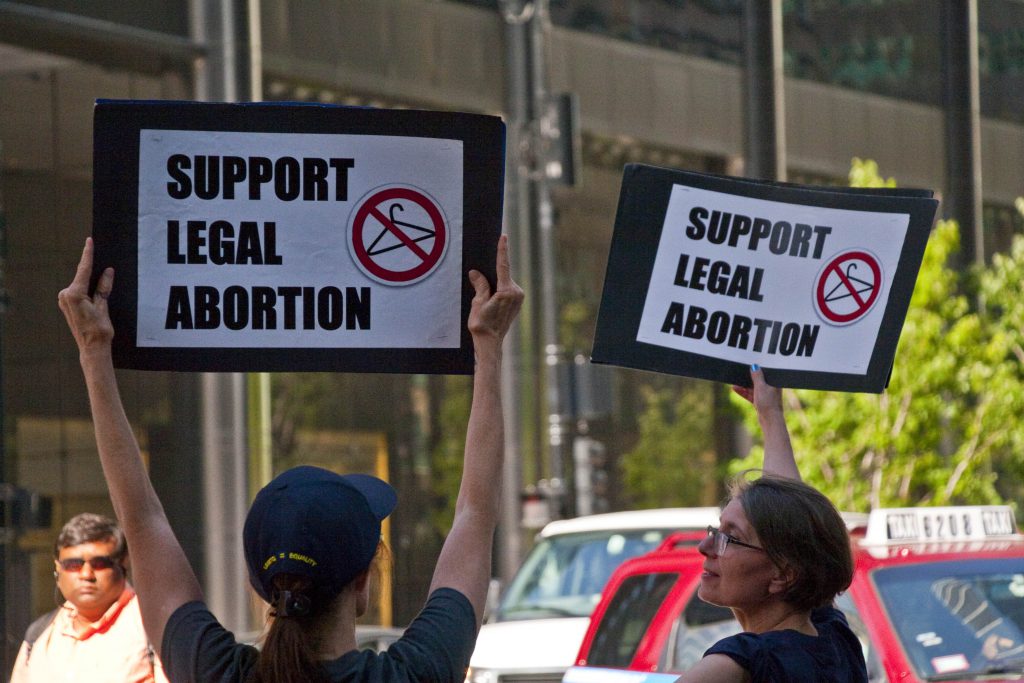Late-Term Abortions Change Voters’ Views
Both in Wisconsin and nationally. But few abortions are done after 16 weeks.

Support legal abortion signs. Photo by Charles Edward Miller. (CC BY-SA 2.0).
In the last decade Wisconsin has changed to become a state that is very hostile toward women seeking abortions. That could become a key issue in the fall elections where a majority of Wisconsin voters support abortion. However, those view can change when it comes to late-term abortions.
As noted in last week’s column, a common practice among pollsters is to ask potential voters to choose among four choices. Abortion should be:
- Legal with no exceptions,
- Legal but with exceptions,
- Illegal but with exceptions, or
- Illegal with no exceptions.
The following graph shows which of these categories were chosen in the 11 times the Marquette poll surveyed Wisconsin voters, followed by the results of three national polls. As happens so often, average Wisconsin voters look very much like national voters. (For simplicity, I excluded people who did not offer an opinion—generally 5% to 10% of the samples.)
None of the four categories gained a majority in any of the polls. However, if one combines the first two categories and the last two, a consensus emerges. In each of the polls about 60% thought that abortion should be legal generally and 40% thought it should be illegal in general. Those who thought it should be illegal in every situation made up much the smallest of the four groups.
All four of the Republicans running for governor have said they support a total ban on abortions, including in the case of rape or incest. This would put them firmly into Group 4 to the right of most Wisconsin voters, and even many Republicans, including Assembly Speaker Robin Vos, who backs an exception in the case of rape or incest. If, as appears likely, abortion assumes a significant role in the fall election, this could become a serious challenge for the winner of the Republican primary.
A likely candidate is pregnancy length, particularly if the respondent is concerned about late-term abortions. Evidence for this comes from a two-step question on a Pew Research Center poll. First, people were asked to identify which one of the four categories they identified with (whether abortion should be legal or illegal and whether there were exceptions). Those who said there were exceptions were then asked whether the pregnancy length mattered. As the next graph shows, an overwhelming number said that it did.
The next graph shows typical abortions: 65% occur by eight weeks. About 4% occur after 16 weeks and slightly over 1% after 20 weeks.
The U.S. Supreme Court built its decision in Casey v. Planned Parenthood of Pennsylvania around the time when the fetus became viable, and theoretically at least, can live outside the womb. This is generally considered to be 23 or 24 weeks. Before viability, the state was limited in what it could do to interfere with the woman’s right to have an abortion. Following viability, the state was far more able to prohibit the procedure.
The next graph shows the dramatic increase in the use of medication abortions, rising from 6% of all abortions 20 years ago to 64% today.
The next graph shows the percentage of women in states rated by their hostility versus support towards those getting abortions. Under the Republican-dominated Legislature several measures were passed making abortions more difficult, and in 2020, Wisconsin’s rating moved from Leans Hostile to Hostile. The portion of women living in states rated hostile and very hostile (shown at the bottom of the chart) has grown substantially in the past decade and includes 57% of the nation’s women. So has the portion rated supportive and very supportive, which now includes 39% of America’s women. Meantime the middle band (in yellow) has almost disappeared, dropping to just 4%.
This pattern reflects the growing national polarization over abortion. The ultimate issue is who makes the decision—the state or the pregnant person? As one moves up this chart, the balance shifts from state control to person control.
Justice Samuel Alito’s draft decision, if adopted by the U.S. Supreme Court, would create a formidable problem for many Republican candidates. Most Americans have accepted the need for legal and safe abortions. Yet much of the Republican base is adamantly opposed. For a GOP candidate to suggest a compromise could be an open invitation to a more ideological Republican opponent and a likely defeat in the primary.
A set of talking points recently issued by the National Republican Senate Committee suggests a likely strategy: change the subject. Rather than propose a policy on abortion before viability, GOP candidates should repeatedly accuse Democrats of supporting late term abortions. Abortion before viability is never mentioned.
Oddly, a belief has arisen in the press that H.R.3755 would have legalized abortions through all nine months of pregnancy. This is the bill, called the Women’s Health Protection Act of 2021, that Senator Chuck Schumer recently introduced in the U.S. Senate. This claim was made in articles published in both the New Yorker and the never-Trump Bulwark, and may have helped defeat the bill, which did not receive the 60 votes needed to overcome a filibuster.
In fact, the text of H.R.3755 mentions late-term abortion (abortion after fetal viability) only once—and that is to protect abortion when “continuation of the pregnancy would pose a risk to the pregnant patient’s life or health.”
It is unclear how the impression the bill allowed late-term abortion could have arisen. Perhaps the lack of mention was taken as permission. But the bill was largely a catalogue of and prohibition of state rules aimed at making early term abortions difficult or impossible to obtain. Thus, by not mentioning late-term abortions, the bill would have allowed state regulation to continue.
Polling suggests that when it comes to early-term abortion, the advocates of a ban are substantially outnumbered. The numbers clearly favor allowing women — and not the government — to decide whether to have an abortion.
Data Wonk
-
Life Expectancy in Wisconsin vs. Other States
 Dec 10th, 2025 by Bruce Thompson
Dec 10th, 2025 by Bruce Thompson
-
How Republicans Opened the Door To Redistricting
 Nov 26th, 2025 by Bruce Thompson
Nov 26th, 2025 by Bruce Thompson
-
The Connection Between Life Expectancy, Poverty and Partisanship
 Nov 21st, 2025 by Bruce Thompson
Nov 21st, 2025 by Bruce Thompson



























So the questions in these polls are very simple. What they fail to point out is that late term abortions are likely the results of late discovery of fetal abnormalities rather than a sudden late desire not to have a child. If the question was asked with this framework, I believe more people would feel that such an exception is justified and that it is not the government’s business. Sadly I have first hand experience and I wish the Republican candidates for governor could take a walk in my shoes. Their positions are academic and they have no appreciation of what it is like to be in this situation.
Not academic. Cruel and misogynistic.